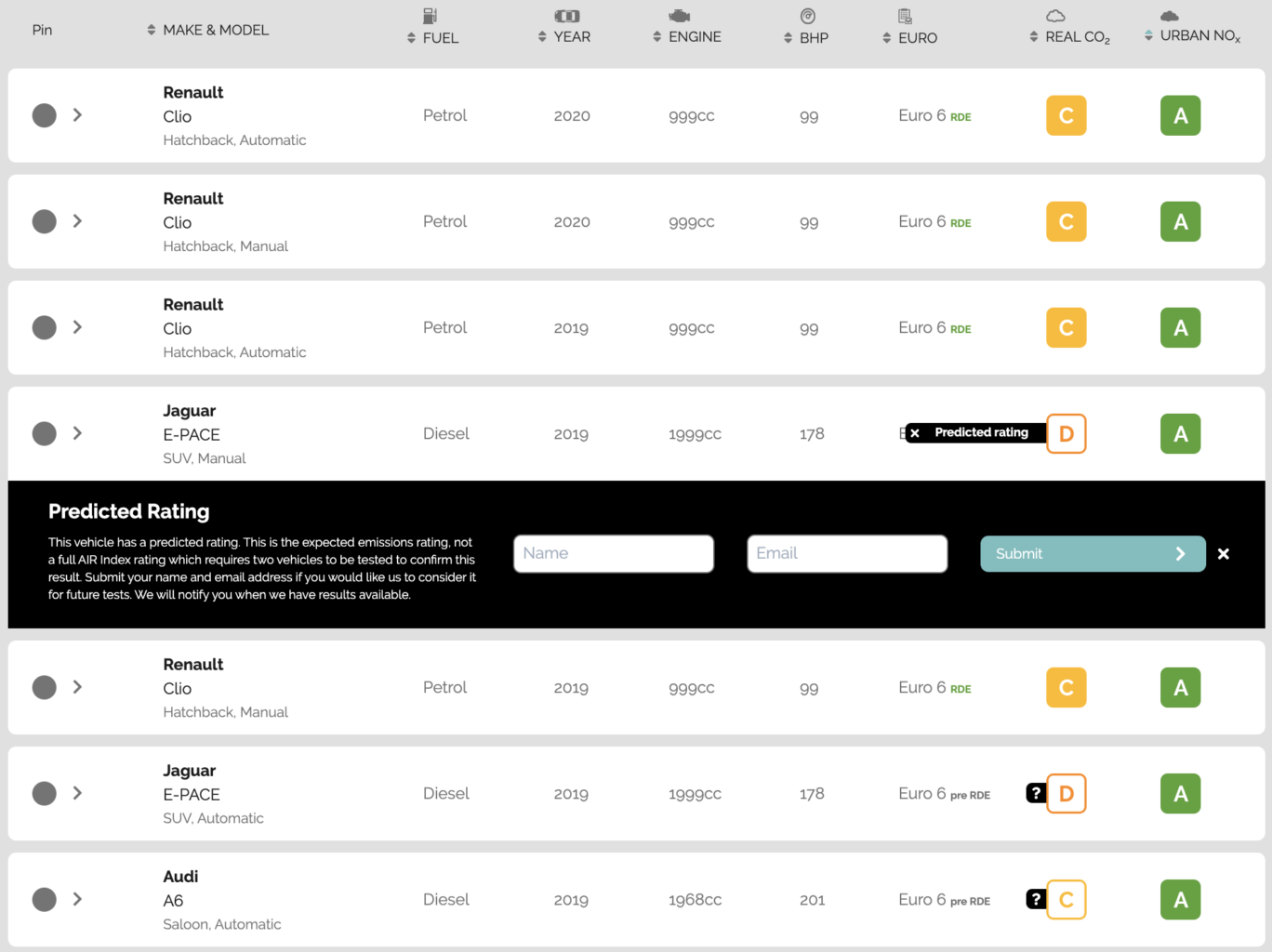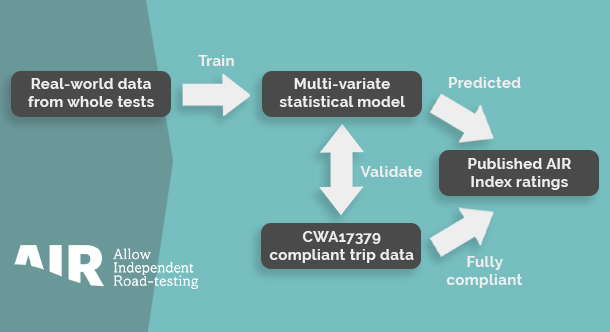Predicted Ratings – Tailpipe Emissions
The expanded range of AIR Index ratings which provide the first realistic alternative to official data about actual on-road NOx and CO2 emissions.
Extending the AIR Index with predicted tailpipe ratings
Full AIR Index ratings are published for cars and vans which have been tested in compliance with the CWA 17379 protocol and meet the AIR Alliance criteria which requires a ‘matched pair’ of vehicles to be evaluated within the strict boundary conditions. These cars and vans are sourced independently from vehicle manufacturers and the data captured by third party test facilities.
We now publish predicted tailpipe ratings for vehicles which have not yet completed testing in full compliance with CWA 17379. These are displayed in the search results with the relevant AIR Index rating ‘blanked out’ as they are not full AIR Index ratings. The predicted rating provides an indication of the expected result for the on-road urban NOx and CO2 emissions when it is tested in accordance with the CWA 17379 European protocol.
We publish predicted ratings to provide science-based information about the on-road emissions for nearly all cars in-use across Europe today, until we can complete the database with full AIR Index ratings. The AIR Alliance is committed to providing full AIR Index ratings and is continuing its mission to secure funding to achieve this.

What is a Predicted Rating?
A predicted rating for NOx and CO2 emissions from a vehicle is an assessment of the likely on-road emissions it will produce, based on statistical modelling of vehicles with similar characteristics.
In 2020, the AIR Alliance commissioned the development of a statistical model to extrapolate both urban NOx and CO2 ratings using data from existing AIR Index testing, partial AIR Index testing as well as modelling previously provided by Emissions Analytics and used by the Greater London Authority (GLA) to assist consumers to check the likely NOx emissions of the vehicles they might choose for urban driving.
Predicted ratings are available for non-hybridised petrol and diesel cars registered since Euro 5 emissions standards came into force on 1 January 2011 and for many hybrids, vans and earlier cars.
How are the results for tailpipe emissions displayed?
Full AIR Index ratings
Full AIR Index ratings are displayed with the rating (from A to E, A being the cleanest), as a letter in a colour-coded box.

Predicted ratings
Predicted ratings provide an indication of the emissions with the rating following the same boundaries as full ratings, (from A to E, A being the cleanest, again), but predicted ratings are shown as a coloured letter in a white box, clearly showing that it is not a ‘full’ rating.

On-screen ratings

How are predicted ratings calculated and applied?
Modelling for CO2 and NOx emissions are based on different statistical approaches, reflecting the differences in the inherent characteristics of the two types of emissions. In both cases, modelling was established using actual test data from Emissions Analytics, and then validated against AIR Index actual test results.
For CO2, a multivariate parametric model was developed, using a wide range of variables including make, fuel type, engine size, power and vehicle weight. This approach was taken due to the relatively smooth and continuous relationship between the input variables and on-road PEMS measured CO2 emissions. The average predictive error from analysing the validation set is 3.3%.
For NOx, it was necessary to use a ‘nearest neighbours’ approach. This reflects the much less smooth and less predictable relationship between the vehicle characteristics and on-road NOx emissions. In the test work and analysis that led to the development of CWA 17379 it was evident that vehicle models developed only one year apart could result in an order of magnitude change in NOx emissions.
To accommodate this variance a scoring system was used to find the nearest equivalent actual test to the model being predicted, with a range of constraints based on our domain knowledge. In this case, the value from the actual test is then used as the predicted emissions rating, without any modification. The average modelling error for NOx is 2.6%.
The principal limitations of this approach to predict NOx ratings are that nearest neighbours could have materially different emissions for some specific vehicles and where vehicles or engine types similar to some vehicles have not been tested. This is a key reason why coverage is below 100%.
How will CWA 17379 test results reduce the variance in predicted ratings in the AIR Index?
The ongoing programme of vehicle testing by the AIR Alliance continuously extends the pool of freely-available information about on-road emissions of NOx and CO2 emissions from cars and vans to inform decision making about vehicle selection and use.
As new data gathered in compliance with CWA 17379 are added to the AIR Alliance data warehouse, there is an incremental improvement in the performance of the statistical model which creates the predicted ratings. This is because it is both training and validating the model and it delivers the dual benefit of growing the number of full AIR Index ratings available and reduces the variance in predicted ratings as shown below.
